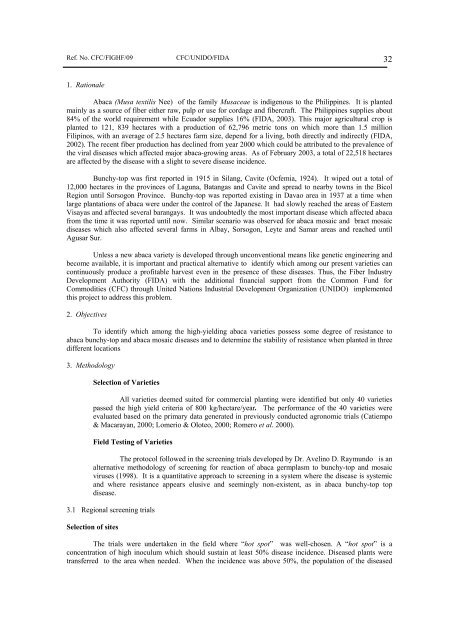ABACA Activities in the Philippines - Unido
ABACA Activities in the Philippines - Unido
ABACA Activities in the Philippines - Unido
You also want an ePaper? Increase the reach of your titles
YUMPU automatically turns print PDFs into web optimized ePapers that Google loves.
Ref. No. CFC/FIGHF/09 CFC/UNIDO/FIDA 32<br />
1. Rationale<br />
Abaca (Musa textilis Nee) of <strong>the</strong> family Musaceae is <strong>in</strong>digenous to <strong>the</strong> Philipp<strong>in</strong>es. It is planted<br />
ma<strong>in</strong>ly as a source of fiber ei<strong>the</strong>r raw, pulp or use for cordage and fibercraft. The Philipp<strong>in</strong>es supplies about<br />
84% of <strong>the</strong> world requirement while Ecuador supplies 16% (FIDA, 2003). This major agricultural crop is<br />
planted to 121, 839 hectares with a production of 62,796 metric tons on which more than 1.5 million<br />
Filip<strong>in</strong>os, with an average of 2.5 hectares farm size, depend for a liv<strong>in</strong>g, both directly and <strong>in</strong>directly (FIDA,<br />
2002). The recent fiber production has decl<strong>in</strong>ed from year 2000 which could be attributed to <strong>the</strong> prevalence of<br />
<strong>the</strong> viral diseases which affected major abaca-grow<strong>in</strong>g areas. As of February 2003, a total of 22,518 hectares<br />
are affected by <strong>the</strong> disease with a slight to severe disease <strong>in</strong>cidence.<br />
Bunchy-top was first reported <strong>in</strong> 1915 <strong>in</strong> Silang, Cavite (Ocfemia, 1924). It wiped out a total of<br />
12,000 hectares <strong>in</strong> <strong>the</strong> prov<strong>in</strong>ces of Laguna, Batangas and Cavite and spread to nearby towns <strong>in</strong> <strong>the</strong> Bicol<br />
Region until Sorsogon Prov<strong>in</strong>ce. Bunchy-top was reported exist<strong>in</strong>g <strong>in</strong> Davao area <strong>in</strong> 1937 at a time when<br />
large plantations of abaca were under <strong>the</strong> control of <strong>the</strong> Japanese. It had slowly reached <strong>the</strong> areas of Eastern<br />
Visayas and affected several barangays. It was undoubtedly <strong>the</strong> most important disease which affected abaca<br />
from <strong>the</strong> time it was reported until now. Similar scenario was observed for abaca mosaic and bract mosaic<br />
diseases which also affected several farms <strong>in</strong> Albay, Sorsogon, Leyte and Samar areas and reached until<br />
Agusar Sur.<br />
Unless a new abaca variety is developed through unconventional means like genetic eng<strong>in</strong>eer<strong>in</strong>g and<br />
become available, it is important and practical alternative to identify which among our present varieties can<br />
cont<strong>in</strong>uously produce a profitable harvest even <strong>in</strong> <strong>the</strong> presence of <strong>the</strong>se diseases. Thus, <strong>the</strong> Fiber Industry<br />
Development Authority (FIDA) with <strong>the</strong> additional f<strong>in</strong>ancial support from <strong>the</strong> Common Fund for<br />
Commodities (CFC) through United Nations Industrial Development Organization (UNIDO) implemented<br />
this project to address this problem.<br />
2. Objectives<br />
To identify which among <strong>the</strong> high-yield<strong>in</strong>g abaca varieties possess some degree of resistance to<br />
abaca bunchy-top and abaca mosaic diseases and to determ<strong>in</strong>e <strong>the</strong> stability of resistance when planted <strong>in</strong> three<br />
different locations<br />
3. Methodology<br />
Selection of Varieties<br />
All varieties deemed suited for commercial plant<strong>in</strong>g were identified but only 40 varieties<br />
passed <strong>the</strong> high yield criteria of 800 kg/hectare/year. The performance of <strong>the</strong> 40 varieties were<br />
evaluated based on <strong>the</strong> primary data generated <strong>in</strong> previously conducted agronomic trials (Catiempo<br />
& Macarayan, 2000; Lomerio & Oloteo, 2000; Romero et al. 2000).<br />
Field Test<strong>in</strong>g of Varieties<br />
The protocol followed <strong>in</strong> <strong>the</strong> screen<strong>in</strong>g trials developed by Dr. Avel<strong>in</strong>o D. Raymundo is an<br />
alternative methodology of screen<strong>in</strong>g for reaction of abaca germplasm to bunchy-top and mosaic<br />
viruses (1998). It is a quantitative approach to screen<strong>in</strong>g <strong>in</strong> a system where <strong>the</strong> disease is systemic<br />
and where resistance appears elusive and seem<strong>in</strong>gly non-existent, as <strong>in</strong> abaca bunchy-top top<br />
disease.<br />
3.1 Regional screen<strong>in</strong>g trials<br />
Selection of sites<br />
The trials were undertaken <strong>in</strong> <strong>the</strong> field where “hot spot” was well-chosen. A “hot spot” is a<br />
concentration of high <strong>in</strong>oculum which should susta<strong>in</strong> at least 50% disease <strong>in</strong>cidence. Diseased plants were<br />
transferred to <strong>the</strong> area when needed. When <strong>the</strong> <strong>in</strong>cidence was above 50%, <strong>the</strong> population of <strong>the</strong> diseased

















